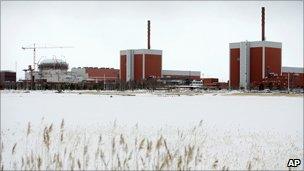Viewpoint: Fukushima makes case for renewable energy
- Published
The Fukushima accident has highlighted one of the most important issues concerning nuclear power - that of safety and risk.

The risk of containment damage at Fukushima was put at one in a million, per reactor per year
The accepted wisdom has been that the consequences of a catastrophic nuclear accident may be large, but that the frequency is low.
The industry and nuclear regulators calculate this on the basis of the likelihood of an accident for any one operating year. In the case of the design of the first four reactors at Fukushima, the Japanese Nuclear Energy Safety Organization estimated in 2002, external: "The frequency of occurrence of a core damage accident is 1/100,000 or less per one year for one reactor and the frequency of occurrence of an accident leading to containment damage is 1/1,000,000 or less per one year for one reactor."
Given that only a few decades, rather than millennia separate the accidents at Fukushima, Chernobyl and Three Mile Island (which were also thought to be at minimal risk of core damage) it is clear that nuclear operators and/or regulators are significantly underestimating the inherent risks associated with nuclear technology.
The Cancun Summit in December 2010 agreed, external: "Climate change is one of the greatest challenges of our time and that all Parties share a vision for long-term co-operative action."
To meet UN targets, emissions must be cut by about 80% by 2050, which will require decarbonising the energy sector.
At the same time, traditional energy forecasts anticipate rapid increases in energy demand, driven primarily by the need to fuel the growing economies in Asia, particularly China and India. The International Energy Agency (IEA) assumes that global energy demand will increase by 47% by 2035.
Energy efficiency
Supporters of nuclear power believe that it should play an increasingly important role in this new, highly efficient, zero-emissions energy sector.
However, nuclear power is not currently a global technology, being employed by only 30 countries with just six - USA, France, Japan, Germany, Russia and South-Korea - producing almost three-quarters of the nuclear electricity in the world.

Finland's Olkiluoto nuclear plant is late, and 50% over budget
The total contribution to global commercial energy production is around 6%, compared to 25% for coal 23% for natural gas.
For nuclear power to play a significant role in meeting future energy demand a significant scaling up of its use will therefore be required, amplifying many-fold the existing problems of nuclear safety, siting and waste management, as well as causing new worries about the proliferation of nuclear materials.
Given the scale and urgency of the problem, it is essential that low-cost technologies with a proven track record of coming in on time and budget, and with global appeal, are prioritised.
The number one priority must therefore be energy efficiency, which not only addresses climate change and energy security problems simultaneously, but also brings demonstrable and rapid economic benefits.
The second area is renewable energy, which, to the surprise of many, has entered the mainstream in the last few years. For example in the EU, renewables installations provided the majority of new capacity in 2008 and 2009, while in Germany they are now bigger contributors to electricity than nuclear power.
This deployment at scale has demonstrated not only the technical capabilities and environmental advantages of wide-spread use of renewables, but also the economic benefits, with reduced dependencies on fluctuating fossil fuel prices.
Nuclear power on the other hand has, at best, had a chequered history of delivery. The most recent example in Europe is the infamous Olkiluoto reactor in Finland, whose original start-up date was May 2009 but which is now at least three-and-a-half years late, and more than 50% over budget.
So whereas nuclear costs have tended to go up, renewables have gone down, and in many conditions are now the cheaper option.
Cascading problems
As a result of Fukushima, most commentators believe that the engineering and financial costs associated with nuclear power will increase further.

Fukushima provided 3% of Japan's electricity
In particular it is expected that there will be a greater emphasis on protecting plants from broader environmental threats such as flooding, storms and droughts (which are expected to become more frequent as a result of climate change).
It is also likely that the cascade of problems at Fukushima, from one reactor to another, and from reactors to fuel storage pools, will also affect the design, layout and ultimately the cost of future nuclear plants.
Numerous studies have shown that renewables along with energy efficiency can deliver all or virtually all of our global energy needs, and that therefore nuclear power does not have to be part of the future (see Related Internet Links at the bottom of this page).
Meanwhile, the ongoing disaster at Fukushima has highlighted the environmental, societal and economic impact that nuclear power can have in extreme conditions.
As Japan addresses the aftermath of the earthquake and tsunami, too much worry, time and effort are having to be spent trying to secure and make safe one facility that provided just 3% of the country's electricity.
Antony Froggatt is a Senior Research Fellow in the Energy, Environment and Resource Governance programme at Chatham House, in London.
His viewpoint follows an earlier argument in favour of nuclear power made Oxford University's Wade Allison -Viewpoint: A new way to look at radiation